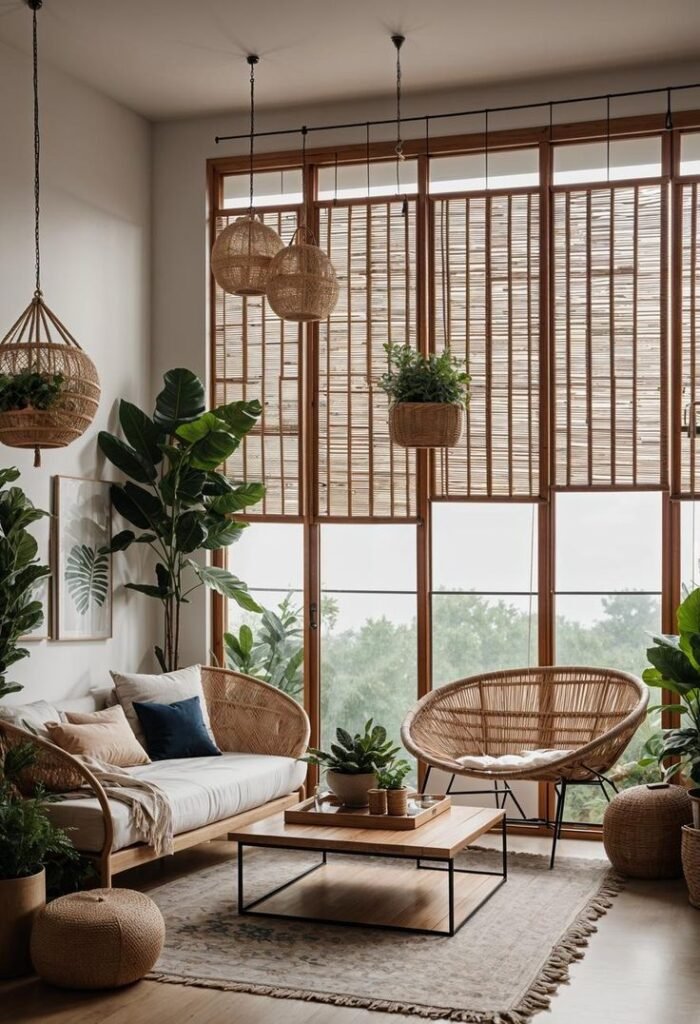

Decorating with rattan, wicker, and bamboo can add a touch of natural charm and timeless elegance to your space. However, common mistakes can diminish the aesthetic and functional appeal of these materials. Here’s a list of the most frequent errors and how to avoid them:
-
-
Overusing Rattan, Wicker, or Bamboo
-
-
- Mistake: Filling a room with too much of one material can make the space feel overly themed or monotonous, like a tropical resort or rustic cabin.
- Solution:
- Mix these materials with other textures and finishes, such as metal, glass, or upholstered pieces, to create balance.
- Use rattan or bamboo as accent pieces (e.g., a single chair, a pendant light, or a mirror) rather than as the dominant material in the room.
-
-
Ignoring Proportions and Scale
-
-
- Mistake: Using oversized or undersized furniture and décor can disrupt the harmony of the room. For example, a bulky rattan sofa might overwhelm a small room, while a tiny bamboo side table may look out of place in a large living space.
- Solution:
- Measure your space carefully before purchasing. Ensure the scale of the furniture aligns with the room’s proportions and other pieces.
- Choose lightweight, airy designs for smaller spaces and sturdier, larger pieces for expansive rooms.
-
-
Placing Them in the Wrong Environment
-
-
- Mistake: Using rattan, wicker, or bamboo in areas exposed to excessive moisture, sunlight, or harsh weather without proper protection can lead to damage such as warping, fading, or mold growth.
- Solution:
- For outdoor use, select weatherproof or treated rattan and wicker furniture. Store them indoors or cover them during bad weather.
- Avoid placing these materials in humid areas like bathrooms unless they are specially treated to resist moisture.
-
-
Neglecting Comfort
-
-
- Mistake: Rattan and wicker furniture can sometimes be uncomfortable without proper cushions or padding.
- Solution:
- Invest in high-quality cushions with removable, washable covers for easy maintenance.
- Choose upholstery that complements the color and texture of the natural material while enhancing the overall comfort.
-
-
Choosing Poor-Quality Pieces
-
-
- Mistake: Opting for cheap or poorly constructed rattan, wicker, or bamboo items can result in furniture that looks tacky and deteriorates quickly.
- Solution:
- Buy from reputable retailers or artisans known for quality craftsmanship.
- Look for sturdy construction, tightly woven patterns, and well-finished edges. Avoid pieces with visible glue, loose strands, or uneven finishes.
-
-
Forgetting to Mix Modern Elements
-
-
- Mistake: Rattan, wicker, and bamboo can sometimes appear outdated or overly traditional when not paired with modern elements.
- Solution:
- Blend these natural materials with sleek, contemporary furniture, metallic accents, or minimalist décor to create a balanced and updated look.
- For example, pair a bamboo chair with a glass-topped table or use a rattan pendant light in a modern, white kitchen.
-
-
Overlooking Maintenance Needs
-
-
- Mistake: Neglecting regular care can lead to a buildup of dust, dirt, or even pest infestations.
- Solution:
- Dust regularly using a soft cloth or vacuum with a brush attachment. Deep clean with a damp cloth and mild soap when needed.
- Keep the pieces away from direct sunlight and excessive moisture to prolong their lifespan.
-
-
Using the Wrong Colors
-
-
- Mistake: Mismatching the natural tones of rattan, wicker, or bamboo with the room’s color scheme can make the space feel disjointed.
- Solution:
- Choose pieces in natural hues that complement the existing color palette. Alternatively, painted or stained options in white, black, or muted tones can fit specific design themes.
- For a cohesive look, coordinate rattan or bamboo items with neutral, earthy tones or use them as a contrast against bolder colors.
-
-
Overloading on Patterns
-
-
- Mistake: Pairing the intricate textures of rattan, wicker, or bamboo with overly busy patterns can make the space feel chaotic.
- Solution:
- Let the natural texture of these materials shine by balancing them with solid-colored textiles or subtle patterns.
- If you want to add patterns, use them sparingly in accent pieces like cushions, rugs, or curtains.
-
-
Misjudging Durability
-
-
- Mistake: Expecting lightweight bamboo or wicker furniture to withstand heavy use can lead to disappointment when it becomes damaged.
- Solution:
- Reserve delicate rattan or wicker pieces for low-traffic areas or occasional use. Use sturdier bamboo for functional items like tables or shelves.
- If durability is a concern, choose reinforced frames or rattan and wicker blends combined with other materials.
-
-
Ignoring the Room’s Style
-
-
- Mistake: Incorporating rattan, wicker, or bamboo into a room with a clashing design theme can make the space feel incoherent.
- Solution:
- Match these materials to styles where they naturally fit, such as bohemian, coastal, tropical, or Scandinavian interiors.
- For modern or industrial themes, use rattan or bamboo sparingly as accents to soften the space.